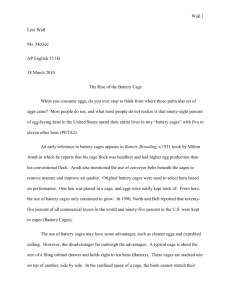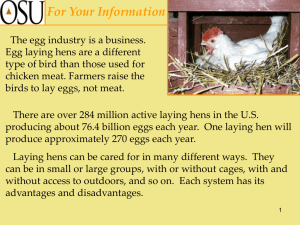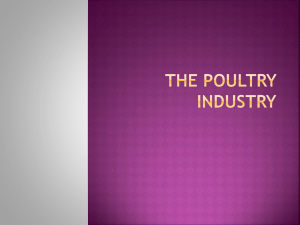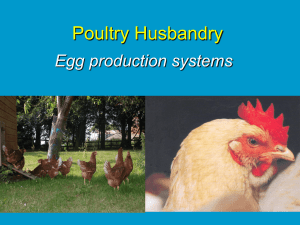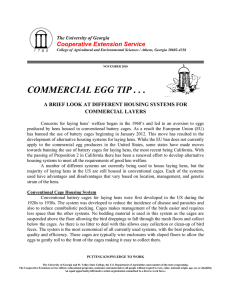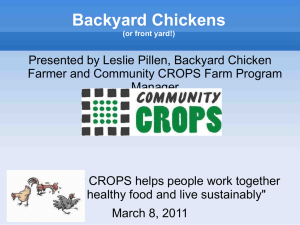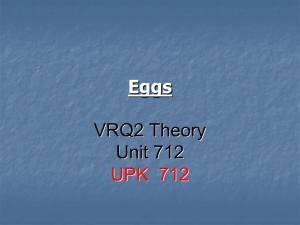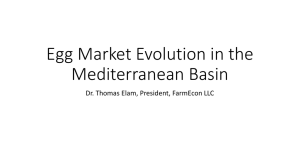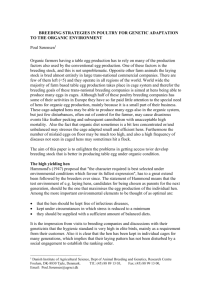EU Egg Industry Background (2009p)
advertisement
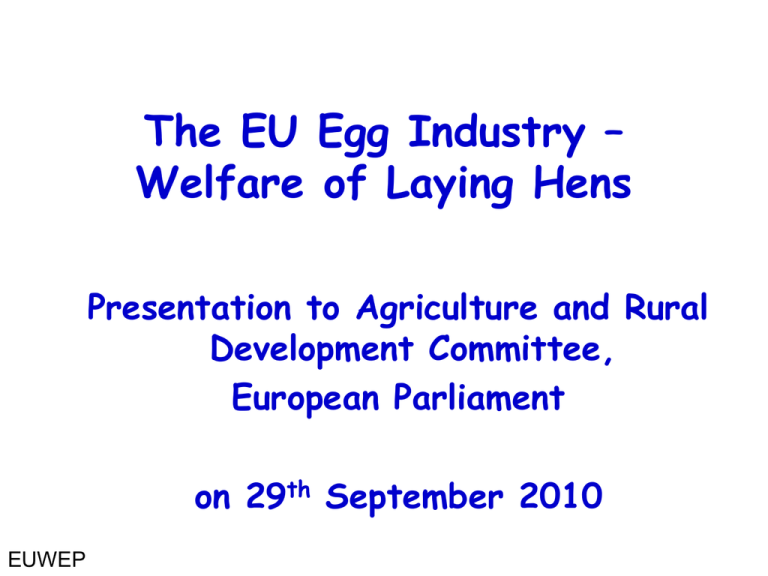
The EU Egg Industry – Welfare of Laying Hens Presentation to Agriculture and Rural Development Committee, European Parliament on 29th September 2010 EUWEP The Key Issues • Egg Industry is working hard to meet full requirements of Council Directive 1999/74/EC by 1st January 2012 – Legislation must be implemented, whilst avoiding problems • Major producers most able to meet deadline on ban on Conventional Cages – Smaller producers unlikely to, or leave industry • EUWEP has real concerns that rate of conversion to either enriched cages or non-cage systems of production is not happening fast enough to ensure full compliance across the EU • If eggs produced by hens, which continue to be housed in a conventional cage, were precluded from being marketed from 1st January 2012, the result would be a massive egg shortage resulting in a significant increase in egg prices • Need to ensure orderly move to either enriched systems or noncage systems, to prevent market distortion 2 EUWEP Updated on 28th May 2010 Data from 26 member states Total 354.67 million hens 154.6m ‘other’ hens not included Source: EUWEP / from DG AGRI data EUWEP 3 Updated on 28th May 2010 Total 353.53 million hens Assumption - Enriched cage growth to 30m hens 147.6m ‘other’ hens not included Source: EUWEP / from DG AGRI data EUWEP 4 Updated on 28th May 2010 Total 353.53 million hens 29% of Laying hens noncompliant on 1st January 2012 Assumptions - Enriched Cage hen numbers increase to 130m - Barn increases to 70m hens - FR increases to 40m hens Source: EUWEP EUWEP 5 What is the likely consequence if 29% of EU hens remain in conventional cages on 1st January 2012? • Scenario 1 - Member states enforce legislation • • 83 million egg a day needing to be disposed of … Leading to … an egg shortage of 83 million eggs a day! But • this cannot be filled by imports from non-EU countries as currently only Switzerland, Croatia and Norway authorised to export shell eggs to EU (due to EU’s Salmonella legislation) • Prices to consumers would increase sharply • In the medium term, EU production is likely to be replaced by imports of eggs and egg products produced to inferior animal welfare standards • This would not benefit laying hen welfare, consumers, industry employment, cereal growers, the environment, EU food security, or the wider economy 6 EUWEP What is the likely consequence if 29% of EU hens remain in conventional cages on 1st January 2012? • Scenario 2 - If more time is given to convert… • If member states do not enforce legislation, or more time is allowed to convert from conventional cages … • Then conventional cage production would continue … • Causing widespread market disruption, severely affecting the viability of many (compliant) businesses as prices and therefore producer returns are depressed – This would affect producers in all systems of production - Cage, Barn, Free Range, Organic • ‘Unfair’ on those producers who have invested • … A different approach is needed 7 EUWEP Suggested Approach (1) • Need to avoid a massive egg shortage in the EU and avoid a significant increase in prices to consumers • If there are some producers who need additional time to phase-out conventional cages, this should be provided – but, maximum of 1-2 laying flock cycles to encourage early compliance – stocking density in CCs must also be reduced to 750cm² per hen • During this time there must be an intra-EU trade ban on table eggs (from conventional cages) to prevent those producers who have made the investment from being commercially disadvantaged – In other words, eggs from conventional cages continuing to operate under this time-limited derogation could only be marketed as table eggs in the member state of production • A clearly set out plan to convert conventional cages to either enriched cages or non-cage systems must be put in place – Must be approved by the national competent authorities – Strict penalties for non-compliance introduced 8 EUWEP Suggested Approach (2) • Enforcement … • To allow enforcement authorities to differentiate between eggs from enriched cages and conventional cages, eggs from an enriched cage would be marked with a No3 from 1st January 2012 and eggs from a conventional cage would be marked with a No4 or other mark. – All egg marking must take place on the production unit • Control is vital. Need increase in FVO inspection visits in 2012 to check for compliance – If non-compliance noted, immediate action to be taken 9 EUWEP Conclusion • Doing nothing is no longer an option! • Council/Parliament/Commission must intervene if all laying hens currently housed in conventional cages in the EU are not converted by 1st January 2012 – to ensure that EU consumers can continue to be offered affordable, high quality, safe, EU produced eggs • EU standards are now among the highest in the world • Must maintain EU model of production to avoid egg production being ‘exported’ to non-EU countries (and then import eggs and egg products from non-EU countries) • Commission has been asked to closely monitor the development of egg production systems in each member state up to 2012 – Member states must be required to report hen numbers housed in both ‘enriched cages’ and ‘conventional cages’ separately 10 EUWEP Annex For background Information 11 EUWEP Annex - EU Egg Industry Background (2009p) • Egg Production (source: EC) – EU – 27 7.427 million tonnes • System of Production (source: EUWEP estimate) • Number of Laying Hens (source: EC) • Egg consumption (EU-27) (source: EC) – 235 eggs/capita/annum, or 14.68 kg/capita/annum • Exports – 140,000 tonnes (1.9% of production) (source: EC) • Imports – 40,000 tonnes (0.5% of production) (source: EC) EUWEP – – Conventional cage 62.5%, Enriched cage 8.5%, Free range 9.2%, Barn 17.1%, Organic 2.7% EU–27 354 million (+ 148m ‘other’ hens) More space per hen, higher cost……. (Source: Van Horne, LEI) EUWEP Production cost eggs 2008, EU and non-EU (Eurocent/kg) (Source: Van Horne, LEI) 100 90 manure 80 electricity 70 euro cent per kg general 60 housing labour 50 53 40 other 50 feed 40 30 38 37 33 pullet 20 10 15 19 10 13 11 11 BR ARG IND 0 NL EUWEP FR US EU Import levies on whole egg powder 2008 (Eurocent/kg) (Source: Van Horne, LEI) 600 500 3 137 137 cent per kg 400 137 137 17 21 21 21 300 499 200 341 375 353 328 USA BR INDIA 100 0 EU ARG production cost EUWEP transport levy on imports EU Import levies whole egg powder 2012 (Eurocent/kg) (Source: Van Horne, LEI) 600 500 3 30 137 137 cent per kg 400 137 137 17 21 -21 -21 300 499 200 341 375 353 328 100 0 EU ARG production cost (excl EU-Directive) EUWEP USA cost of EU-Directive BR transport INDIA levy on imports EU Enriched Colony (Source: Big Dutchman) 17 EUWEP Number of EU Laying Hens by System of Production (‘000) (2004 – 2012F) Updated on 28 May 2010 th 34.2 m Romanian ‘back-yard’ hens included as FR Enriched cage included for first time Non-compliant hens from 1/1/12 Source: EUWEP / from DG AGRI data EUWEP
